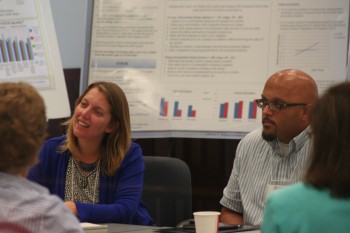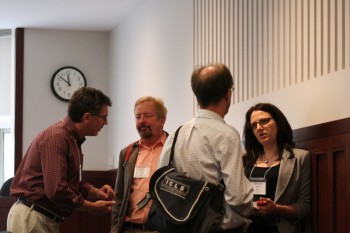 “How can we help students transfer problem-solving skills to novel contexts?”
“How can we help students transfer problem-solving skills to novel contexts?”
“How can we better use words and graphics to improve student learning?”
“How can we get our pedagogies in line with how the brain works?”
These were some of the questions in the air at the 2nd CIRCLE Conference, “Integrating Cognitive Science with Innovative Teaching in the STEM Disciplines,” which was held September 11-12, 2014 at the Knight Center.
Integrating scholarly research on cognitive psychology and STEM education, this national conference bridged the gap between learning theory and STEM education. Featuring cutting-edge research on innovations in higher education across a variety of STEM fields (biology, chemistry, engineering, physics, and psychology) and pertinent research from cognitive and educational psychology, the conference considered the current state of knowledge on the science of education, identified outstanding remaining issues, and provided fruitful directions for continuing development of an evidence-based framework for STEM education.
The two-day event brought together cognitive and learning science researchers with STEM faculty conducting scholarly research on innovations in their classrooms, such as a creative engineering “kitchen,” multimedia modules for physics courses, and online tutorial programs calibrated to gaps in student learning.

Part of the conference’s focus was on engaging and retaining first-year students in STEM courses, a topic that generates discussion of active learning. Key to these concerns of attention and engagement—and central to the conference itself—was another question voiced early on by chemistry professor Diane Bunce: “How can we get our pedagogies in line with how the brain works?”
On this topic, participants heard talks by researchers on metacognition and multimedia instruction as well as shared, via posters, their own research questions on subjects ranging from approaching classrooms as social networks to cultivating students’ cognitive abilities in organic chemistry.
 The conference format fostered animated conversation throughout the days. Time was divided between 25-minute formal talks, followed by 20 minutes for audience questions and discussion. Late afternoon featured lively, self-selected roundtable discussions stemming from the day’s main talks, and Thursday evening ended with poster presentations that generated more discussion. Breakfast and lunch allowed opportunities for continued conversation.
The conference format fostered animated conversation throughout the days. Time was divided between 25-minute formal talks, followed by 20 minutes for audience questions and discussion. Late afternoon featured lively, self-selected roundtable discussions stemming from the day’s main talks, and Thursday evening ended with poster presentations that generated more discussion. Breakfast and lunch allowed opportunities for continued conversation.
This year’s event, which drew 96 participants, has grown significantly from the 64 who attended the first conference in 2012. This year’s participants expressed interest in continuing the conversation as a learning community throughout the year, and conference leaders plan to hold similar events in the future.
For details on the 2014 conference’s schedule of talks and speaker profiles, please see the conference website.
We would like to thank our sponsors, The Luce Foundation, The Office of the Provost, and the Department of Psychology at Washington University for their generous support that helped make the CIRCLE conference possible.